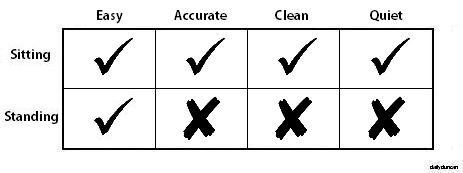Scaring people is great. There are few things more satisfying than choosing the perfect hiding spot, crouching down and breathing as quietly as possible as you wait for your victim. Your ankle starts to hurt, but you don’t shift your weight because it might make a noise. You feel the need to cough but resist, lest you spoil the ambush. Finally you hear those footsteps and tense up, ready to pounce.
“Rawwwrr!”
Mission accomplished. For a split second the person forgot they lived in a safe, normal world where nothing is trying to kill them. Logical thought processes are temporarily disabled as they react with pure instinct, usually spitting out some stuttered jibberish or swatting at you. It’s these moments of raw behavior that reveal that our grasp on reality is a little looser than we’d like to think. We want to believe that if we saw a monster or an alien, or even a monster-alien hybrid, we would know that it’s a trick and not succumb to irrational fear of something that we all know does not exist. This is not true; what we see and feel is more powerful than what we know.
There are television shows which use hidden cameras to capture these raw moments as unsuspecting pedestrians are subjected to cruel comedic experiments. On one of these shows, a man acting as a zookeeper asks the target if they have seen an escaped gorilla. This all unfolds in broad day light in a busy public park, by the way. Several moments after the zookeeper walks away, a man in a gorilla suit charges the victim and they shriek and flee in terror. But hold on, why would someone believe that an escaped gorilla was wandering around a public park? There are many other scenarios on this show more ridiculous than gorillas in a park, and they all prey on the fact that emotion is more powerful than reason and that perception is greater than knowledge. In the moment when we are confronted with incredible and frightening situations, all that we know about the world evaporates.
Something that is just as awesome, if not more awesome, than scaring a person is allowing the person to scare themselves. If you scare someone enough times, or create situations in which the person expects to be scared, then your objective is completed before you’ve actually done anything. The old saying about the fear of the unknown is accurate, but to truly drive terror into someone’s heart you must also create the second level of fear – the fear of being frightened.
These two forms of fear are known as horror and terror. Horror is the sensation of observing something frightening or repulsive. and terror is the feeling of dread that comes before you see it. As an example, consider a child laying awake at night on his bed, frightened of the monster he believes resides beneath him. His mind is generating images of what might be under the bed, but he doesn’t look. It’s his terror that keeps from peeking below the frame and discovering something that might horrify him – he’s afraid of being scared.
Legendary horror fiction author, Stephen King, praises terror as the finest emotion, and this is what you must use against your victim. Simply ambushing someone and frightening them with a loud noise, while gratifying, fails to generate penetrating, long-lasting fear. You must prey upon your victim’s terror – their fear of being scared – in order to create a haunting fear from which they never truly recover.
Your tactics need not be elaborate. Next time your favorite victim is in the washroom, simply turn the lights off in the living room and go outside; their own fear of being scared will do the rest. Then, a few minutes later, you can tap on the window or pound on the door, then enter and find them shaking in the corner with tears running down their face. Perfect.
Another simple method that works great on guests is closing the shower curtains in your bathroom. They must be opaque curtains, and your shower must be large enough for your victim to fill it with an imaginary murderer. As they relieve themselves they will glance at the curtain and think, “Hmm, there could be a person behind there, maybe even a murderer,” and they’re well on their way to being terrified.
Scaring people makes life more exciting.

